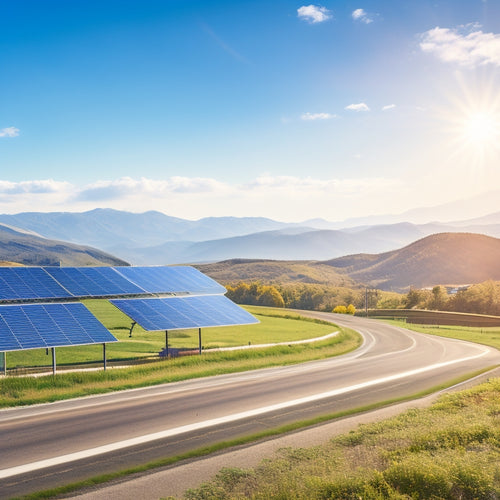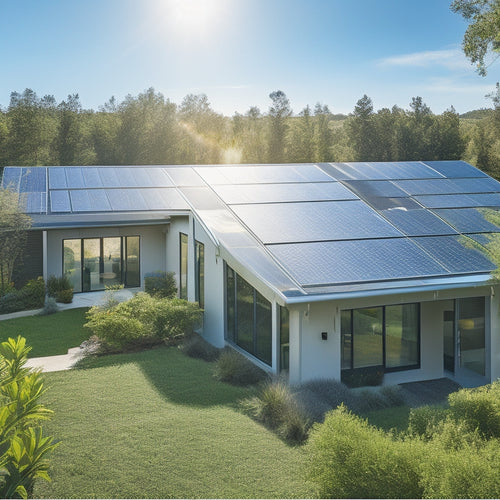
What You Need to Know for Home Installation
Share
When planning your home solar installation, you'll need to assess your home's solar potential by evaluating its orientation, shading, and energy efficiency. Choose the right solar panels for your needs, considering factors like efficiency, cost, and type (monocrystalline, polycrystalline, or thin-film). Understand the key components of solar panel systems, including inverters, mounting hardware, and monitoring systems. Consider mounting and installation options, such as roof type and installation angles, and prioritize safety when connecting to the grid. By grasping these fundamentals, you'll be well-prepared to steer through the installation process and maximize your solar investment's potential - and that's just the beginning of your expedition.
Overview
- Assess your home's solar potential by evaluating its orientation, shading, and energy efficiency to determine the optimal system size and configuration.
- Choose the right solar panels based on your budget and energy needs, considering factors such as efficiency, cost, and type (monocrystalline, polycrystalline, or thin-film).
- Ensure a safe and efficient installation by selecting the appropriate mounting system, inverter, and monitoring system, and following National Electric Code (NEC) regulations.
- Properly maintain your solar panel system through regular monitoring, cleaning, and inspections to ensure optimal performance and longevity.
- Research and take advantage of available incentives, such as federal tax credits, state rebates, and local programs, to maximize your investment benefits.
Assessing Your Home's Solar Potential
Most homes have some degree of solar potential, but it's essential to evaluate yours to determine how much energy you can capture.
You'll need to assess your home's solar orientation, which affects the amount of sunlight your solar panels will receive. A south-facing roof with little to no shading is ideal, but don't worry if your roof doesn't fit this description - you can still utilize solar energy.
When selecting solar panels, careful consideration of system sizing and energy efficiency measures can greatly reduce energy needs.
Conduct a shading analysis to identify areas where trees, buildings, or other obstructions may cast shade on your solar panels. This analysis will help you determine the best placement and size of your solar array.
Choosing the Right Solar Panels
You've assessed your home's solar potential and determined the best placement and size for your solar array. Now, it's time to choose the right solar panels.
You'll need to take into account two key factors: solar panel types and efficiency ratings. There are three main types of solar panels: monocrystalline, polycrystalline, and thin-film. Monocrystalline panels are the most efficient, but also the most expensive. Polycrystalline panels offer a balance between efficiency and cost. Thin-film panels are the least expensive, but also the least efficient.
When selecting a solar panel system, it's important to weigh top brands like Renogy, HQST, and WindyNation, which are recognized for their high-efficiency solar panels. Additionally, proper sizing and panel orientation are vital for maximizing energy production efficiency regardless of the system type.
Efficiency ratings range from 15% to 22%. Higher efficiency panels generate more power per hour of sunlight. When selecting solar panels, balance your energy needs with your budget to achieve the freedom and independence you desire.
Understanding Solar Panel Systems
You're now ready to understand how solar panel systems work, and that starts with identifying the key components that make up a system.
These components include the solar panels themselves, an inverter, mounting hardware, and a monitoring system.
High-efficiency inverters with an efficiency rating above 95% optimal energy production play an essential role in the system, as they directly impact overall energy production.
You'll also want to understand how these components impact the system's energy output, which is typically measured in watts (W) or kilowatts (kW).
Solar Panel Components
Comprising several key elements, a solar panel system is a complex network of components working in harmony to convert sunlight into electrical energy. You'll need to understand these components to make informed decisions about your home installation.
| Component | Function | Options |
|---|---|---|
| Solar Panels | Convert sunlight to DC power | Monocrystalline, Polycrystalline, Thin-film |
| Solar Inverter | Convert DC power to AC power | String, Micro, Power Optimizer |
| Mounting System | Secure panels to your roof or ground | Roof-mounted, Ground-mounted, Tracking systems |
When choosing solar panel types, consider factors like efficiency, cost, and durability. For solar inverter options, think about the system's size, complexity, and monitoring capabilities. By understanding these components, you'll be able to design a system that meets your energy needs and budget.
System Energy Output
The system energy output of a solar panel system is an essential factor in determining its overall performance and ability to meet your energy needs.
You need to guarantee that your system is designed to produce enough energy to power your home efficiently. System sizing plays a vital role in achieving peak energy efficiency. A properly sized system will maximize your energy output, reducing your reliance on the grid and saving you money on your utility bills.
When sizing your system, consider factors such as your energy usage patterns, roof size, and local climate.
Mounting and Installation Options
Several mounting and installation options are available to guarantee a secure and efficient setup of your home system.
You'll need to take into account your roof type, as different materials require specific mounting solutions. For instance, asphalt shingle roofs require a standard rail mounting system, while metal roofs may require a standing seam clamp.
Installation angles are also vital, as they affect energy output. You can choose from flush mounting, where panels are installed parallel to the roof, or tilt mounting, which allows for ideal energy harvesting.
Additionally, you may opt for a ballasted system, which uses weighted components to secure the panels, or a penetrating system, which anchors into the roof.
Connecting to the Grid Safely
When connecting your home installation to the grid, you must prioritize safety above all else.
You'll need to guarantee safe voltage handling by following established protocols for working with high-voltage electrical systems.
Additionally, you must comply with relevant regulations, such as those set by the National Electric Code (NEC), to avoid electrical shock, fires, and other hazards.
Grid Connection Safety
Grid connection safety is paramount to ensuring your home installation operates efficiently and safely. You must take electrical hazards seriously, as they can be deadly.
To mitigate these risks, you'll need to implement safety protocols that guarantee a secure connection to the grid. This includes ensuring your installation meets local electrical codes, using certified equipment, and following manufacturer guidelines.
Additionally, you should install surge protectors and grounding systems to prevent electrical shocks and fires.
Safe Voltage Handling
Every 120/240-volt electrical connection poses a significant risk of electrical shock, and it's crucial you take the necessary precautions to handle voltage safely.
You must guarantee you're properly trained and equipped to handle high-voltage connections. Wear personal protective equipment, such as insulated gloves and safety glasses, to prevent electrical shock.
Always turn off the main power supply before working on electrical systems to eliminate voltage safety risks. Verify the absence of voltage using a multimeter or voltage tester to guarantee your safety.
Be aware of your surroundings, keeping a safe distance from electrical hazards like exposed wires and sparking components.
Compliance With Regulations
Connecting to the grid safely requires adhering to established regulations and industry standards, which you must familiarize yourself with before proceeding with the home installation.
You'll need to research and comply with local building codes, permits, and energy efficiency standards. Confirm your system meets the necessary safety and performance requirements to avoid penalties, fines, or even system shutdown.
Familiarize yourself with national and local regulations, such as the National Electric Code (NEC) and your local building department's requirements. Additionally, obtain necessary permits and undergo inspections to validate your system is installed correctly and safely.
Monitoring and Maintaining Performance
With your home installation up and running, you're now in a position to optimize its performance and affirm it continues to meet your energy needs efficiently. Effective performance tracking is vital to identifying areas of improvement and guaranteeing your system operates at its best. Regular maintenance is also essential to prevent issues and prolong the lifespan of your equipment.
| Task | Frequency | Tips |
|---|---|---|
| Inspect panels and connections | Quarterly | Check for signs of wear, corrosion, or damage |
| Clean solar panels | Bi-annually | Use a soft brush and mild soap to maintain energy absorption |
| Check inverter performance | Monthly | Monitor energy output and alertness to potential issues |
| Perform software updates | As needed | Confirm you have the latest features and security patches |
| Schedule professional maintenance | Annually | Hire a certified technician to inspect and repair your system |
Incentives and Rebate Opportunities
As you settle into your newly installed home energy system, you're likely wondering how to maximize its benefits.
Fortunately, you can capitalize on various incentives and rebate opportunities to offset the upfront cost. Federal incentives, such as tax credits, offer significant financial savings. Additionally, state rebates and local programs provide further discounts.
These incentives not only reduce your initial investment but also contribute to long-term energy efficiency and environmental benefits.
To investigate available options, research financing alternatives that can help you make the most of your investment.
Frequently Asked Questions
Can I Install Solar Panels on a Metal or Clay Tile Roof?
You'll face unique installation challenges with metal or clay tile roofs, requiring specialized mounting systems and careful planning to guarantee a secure, watertight fit, so it's vital to take your roof type into account carefully before installation.
Are Solar Panels Resistant to Hail and Extreme Weather?
Like a shield defending your home, solar panels are built to withstand the fury of hail and extreme weather, boasting extraordinary weather durability; you can rest assured that hail damage is highly unlikely, giving you freedom from energy worries.
Will Solar Panels Void My Roof's Warranty?
You're wondering if solar panels will void your roof's warranty. Rest assured, most reputable roof manufacturers won't void their warranty due to solar panel installation, as long as you choose compatible solar panel types and guarantee proper roof installation.
Can I Install Solar Panels Myself to Save Money?
You're not alone in considering DIY installation, as 20% of homeowners attempt it; however, you'll likely void warranties and compromise system efficiency, offsetting any potential cost savings, so it's recommended to leave it to the pros for best results.
Are Solar Panels Compatible With My Home's Insurance Policy?
You'll need to review your insurance policy to guarantee solar panels are covered; check policy limitations and exclusions to understand what's protected and what's not, as insurance coverage varies widely, and you don't want surprises down the line.
Ready to Buy
As you commence your solar expedition, remember that knowledge is power - and in this case, it's electricity! With the right assessment, panel selection, and installation, you'll be utilizing the sun's energy in no time. Don't get left in the dark; stay connected to the grid and monitor your system's performance. And, sweeten the deal with incentives and rebates. Now, shine on and reap the rewards of going solar!
Related Posts
-

Is Switching to Green Energy Solutions Easy
Switching to green energy solutions isn't just easy; it's also beneficial. You can greatly cut utility costs and enjo...
-

Top 10 Off Grid Camping Gear Must-Haves
When you're off-grid camping, the right gear is crucial for a smooth expedition. Start with a durable, weather-resist...
-

Installing Metal Solar Roofs for Maximum Energy Efficiency
Installing metal solar roofs can drastically enhance your home's energy efficiency and durability. These roofs withst...


